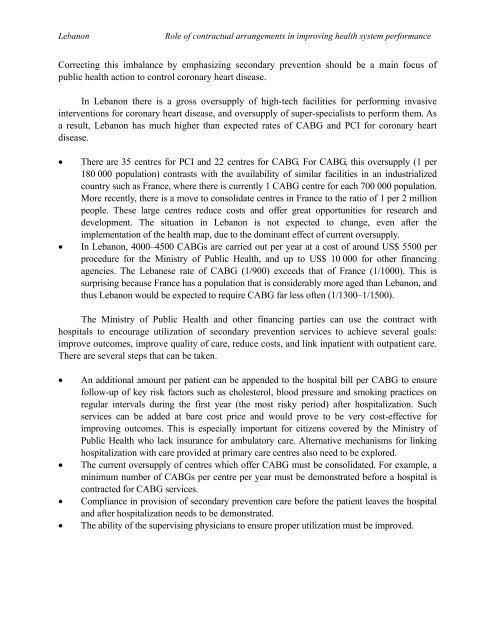Lebanon - What is GIS - World Health Organization
Lebanon - What is GIS - World Health Organization
Lebanon - What is GIS - World Health Organization
You also want an ePaper? Increase the reach of your titles
YUMPU automatically turns print PDFs into web optimized ePapers that Google loves.
<strong>Lebanon</strong> Role of contractual arrangements in improving health system performance<br />
Correcting th<strong>is</strong> imbalance by emphasizing secondary prevention should be a main focus of<br />
public health action to control coronary heart d<strong>is</strong>ease.<br />
In <strong>Lebanon</strong> there <strong>is</strong> a gross oversupply of high-tech facilities for performing invasive<br />
interventions for coronary heart d<strong>is</strong>ease, and oversupply of super-special<strong>is</strong>ts to perform them. As<br />
a result, <strong>Lebanon</strong> has much higher than expected rates of CABG and PCI for coronary heart<br />
d<strong>is</strong>ease.<br />
• There are 35 centres for PCI and 22 centres for CABG. For CABG, th<strong>is</strong> oversupply (1 per<br />
180 000 population) contrasts with the availability of similar facilities in an industrialized<br />
country such as France, where there <strong>is</strong> currently 1 CABG centre for each 700 000 population.<br />
More recently, there <strong>is</strong> a move to consolidate centres in France to the ratio of 1 per 2 million<br />
people. These large centres reduce costs and offer great opportunities for research and<br />
development. The situation in <strong>Lebanon</strong> <strong>is</strong> not expected to change, even after the<br />
implementation of the health map, due to the dominant effect of current oversupply.<br />
• In <strong>Lebanon</strong>, 4000–4500 CABGs are carried out per year at a cost of around US$ 5500 per<br />
procedure for the Min<strong>is</strong>try of Public <strong>Health</strong>, and up to US$ 10 000 for other financing<br />
agencies. The Lebanese rate of CABG (1/900) exceeds that of France (1/1000). Th<strong>is</strong> <strong>is</strong><br />
surpr<strong>is</strong>ing because France has a population that <strong>is</strong> considerably more aged than <strong>Lebanon</strong>, and<br />
thus <strong>Lebanon</strong> would be expected to require CABG far less often (1/1300–1/1500).<br />
The Min<strong>is</strong>try of Public <strong>Health</strong> and other financing parties can use the contract with<br />
hospitals to encourage utilization of secondary prevention services to achieve several goals:<br />
improve outcomes, improve quality of care, reduce costs, and link inpatient with outpatient care.<br />
There are several steps that can be taken.<br />
• An additional amount per patient can be appended to the hospital bill per CABG to ensure<br />
follow-up of key r<strong>is</strong>k factors such as cholesterol, blood pressure and smoking practices on<br />
regular intervals during the first year (the most r<strong>is</strong>ky period) after hospitalization. Such<br />
services can be added at bare cost price and would prove to be very cost-effective for<br />
improving outcomes. Th<strong>is</strong> <strong>is</strong> especially important for citizens covered by the Min<strong>is</strong>try of<br />
Public <strong>Health</strong> who lack insurance for ambulatory care. Alternative mechan<strong>is</strong>ms for linking<br />
hospitalization with care provided at primary care centres also need to be explored.<br />
• The current oversupply of centres which offer CABG must be consolidated. For example, a<br />
minimum number of CABGs per centre per year must be demonstrated before a hospital <strong>is</strong><br />
contracted for CABG services.<br />
• Compliance in prov<strong>is</strong>ion of secondary prevention care before the patient leaves the hospital<br />
and after hospitalization needs to be demonstrated.<br />
• The ability of the superv<strong>is</strong>ing physicians to ensure proper utilization must be improved.
















